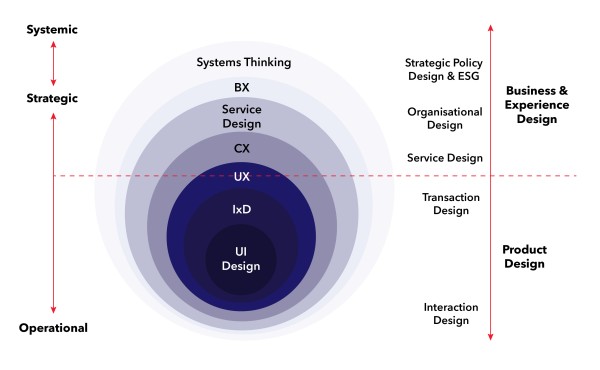In 2025, all organisations need to continuously transform to meet their strategic goals or risk obsolescence. This urgency puts digital transformation firmly at the top of the leadership agenda. Yet, the vast majority of digital transformation programmes fail to meet their objectives, wasting billions, if not trillions, of pounds in the process. This article looks at why that’s happening and how Service Design’s human-centred design approach can help assure digital transformation projects and avoid costly failures.
The Colossal Scale of Digital Transformation Failure
The aim of digital transformation is clear: integrate new or improved digital technologies into an organisation to fundamentally change how it operates and delivers value. The ‘megatrends’ driving this need for reinvention - which we wrote about in a previous article - are also clear: relentless technological change, evolving user preferences and expectations, regulations, increased competition, as well as systemic issues like climate change.
Yet, it’s not clear that digital transformation programmes themselves are delivering on these critical aims.
The often-quoted headline figure from McKinsey that 70% of digital transformation projects fail to meet their objectives might even underestimate the problem. BCG, KPMG and Bain & Co have stated that failure rate could be as high as 95%.
Either way, when the global spend on digital transformation is estimated north of two trillion U.S. dollars (other estimates stating over 10 trillion U.S. dollars), the scale of potential waste is staggering.
The public sector isn’t immune either. The recent State of Digital Government Review found high failure rates of its cc.£25bn+ annual spend, echoing earlier work by the National Audit Office which also found negative and even dangerous service impacts in the roll-out of digital projects.
With so much at stake for all types of organisations, users and society at large, why are things going so badly wrong?
Why digital transformations fail
There are untold articles, research pieces – and of course government reviews – looking at the reasons for these digital transformation failures.
My experience working on large-scale transformation initiatives in 360° roles across different sectors and markets as a Strategist, Agile Delivery Lead, Tech Lead, Business Change Manager and Operations Director points to the following themes:
- Too much focus on digital customer and user experience without considering internal operations and goals – trying to UX their way out of poorly developed services that are not operationally or commercially viable
- The prioritisation of business objectives that ignore how such change impacts people and systems in practice – leading to over-emphasis on ‘what the business wants to achieve’
- A lack of human assets such as insufficient leadership and missing people and skillsets that impede an organisation’s ability to do things differently – often due to power struggles and simple misalignment of thinking
- A failure to align transformation across multiple levels of the organisation, creating silos instead of connected change – often driven by the bureaucratic nature where those who make decisions are too far upstream to those who understand how it takes to deliver
- The lack of a structured way to track, measure, and refine transformation as it progresses – solely measuring financial outcomes rather than user engagement and technology adoption rates, for example
What underpins these themes is the inability, or sometimes even unwillingness of leaders, to join the dots across the organisational system and recognise its how technology, operational processes and human capabilities combine that delivers the desired change outcomes.
So, what does this failure to connect the dots look like in practice?
Complex lives, simple systems
The digital rollout of Universal Credit, the UK Government’s flagship welfare reform, illustrates the human cost when digital ambition outpaces design and, more importantly, the development of a service that has dramatic impact to human welfare.
Although positioned as a 'digital-first' service, early iterations of Universal Credit ignored the complex realities of claimants' lives — leading to payment delays, hardship, increased debt, foodbank usage, and administrative and resource chaos.
The National Audit Office and multiple independent reviews found that "digital assumptions left vulnerable groups worse off," and that the system exacerbated existing inequalities rather than alleviating them.
Billions in unanticipated support measures have been needed to mitigate system failures, demonstrating that digital transformation without human-centred design doesn't just fail financially — it actively causes social harm.
Modernisation without people
The HM Courts and Tribunals Service (HMCTS) £1.3 billion reform programme offers a recent warning about the cost of overlooking human-centred design.
Intended to modernise the UK’s justice system through digitalised services and reduced physical environments (courts), it drew sharp criticism from the Public Accounts Committee in 2022 for failing to adequately consider vulnerable users, offered poor user engagement, and relied on overly optimistic assumptions about operational change.
Significant risks soon emerged around access to justice, with evidence that digitally excluded people were unable to engage with online services, directly impacting fairness and equity — foundational principles of public services, right?
As the National Audit Office observed, "service users have often been treated as an afterthought” in critical redesign decisions.
Two illustrative examples showing that they effectively focused on the ‘what’ needs to change, but not the ‘how’ or ‘why’. And without the ‘how’ and ‘why’ it’s impossible to identify the outcomes and set the right indicators to see what’s working and how to change course if necessary. And thus the stratospheric digital transformation failure rates.
Why a human-centred design approach to transformation is needed
Although any digital transformation will likely involve reengineered processes or systems being upgraded or replaced entirely, without the human component being central to developing the strategy and implementation around this, meaningful and sustainable change is simply not possible.
It sounds dramatic, but it can’t be emphasised enough. A series of research projects by the Saïd Business School finds that human-centred approaches to digital transformation have a 12x greater likelihood of transformation performance than those that don't.
And by human-centred approaches, they mean leaders and change programmes that “mitigate emotional harm to — and drive emotional commitment from — employees” and “engage users on an emotional level – and...appeal to their teams through communications which empower, encourage collaboration and build community.”
Emotions, harms, empower, community… the sorts of deeply human words that don’t usually feature heavily in business plans, traditional ‘Big Three’ consulting strategies or digital transformation project outlines but are the key to success.
The Six Levels of Design for Transformation
So, if the heart of any transformation is people, transformation happens around them at different levels. From the interactions and touchpoints, they have with different tools and systems right the way to the broadest systemic changes affecting the entire organisational ecosystem. These levels define what needs to be or is naturally transformed and help determine the type of design thinking.
These levels provide a structured way to define the scope and focus of transformation efforts and help determine the type of design thinking required.

The six levels of design transformation - from systemic and organisational through to product, transaction and interaction
1) Interactions – the micro-moments that shape experiences
This is the smallest yet most impactful layer of transformation for people (especially customers and employees). Every button clicked, every swipe, every conversation, and every moment of engagement defines a person’s experience. These micro-moments, when well-designed, create frictionless interactions that lead to satisfaction and trust.
An example in this space could be optimising a website’s user interface to improve accessibility and usability or re-designing the way an engineer engages with a customer when the attend a property to fix a boiler - or how that engineer discusses personal development with their organisation.
2) Transactions – the exchanges of value that build trust
Transactions are more than just payments; they represent trust between people and organisations. A cumbersome process can erode confidence, while a seamless experience reinforces reliability and trust. Whether it’s making a purchase, booking an appointment (digitally, in-person or on a call), or submitting a request, designing transactions with clarity and efficiency ensures that users feel secure and valued.
Simplifying an online checkout process to reduce friction and increase conversions, or even reimagining an exchange of goods in retail are great examples of a transactional
3) Products – the tools and offerings people use
Products are the tangible phygital (physical or digital) things people use to get things done. Whether it’s an app, a piece of software, or a physical product, well-designed offerings anticipate user needs and deliver value efficiently. Failing to design products with user needs in mind leads to disengagement and inefficiencies.
Think of redesigning a banking app to better meet customer needs and regulatory compliance or improving the smell and taste of a coffee in a cafe - these all take careful design and understanding the journey to and from the product.
4) Services – the full end-to-end experience
A service is the sum of all interactions and transactions within an experience, and the products that bring things to life.. It spans across multiple touchpoints, requiring alignment across digital and physical environments to create experiences that matter and are both loved by people and valuable for those who provide them. Without a well-designed service, even the best interactions, transactions and products can fall apart or fail (or both). This level ensures holistic thinking that removes silos and optimises entire experiences.
A great example here is redefining healthcare service pathways to improve patient care and reduce waiting times. We’ve all seen the digitisation and transformational changes in how we get to care and often how care is provided, but at a service level we still find the operationalisation and improvement in the physical world lags far behind.
5) Organisations – the structures, processes, and culture that enable services
Services don’t operate in a vacuum. They are enabled (or hindered) by organisational structures (or if you're lucky and forward thinking, lack of them), internal processes, and company culture. Many transformations fail because they focus on external change without considering the internal shifts needed to support new ways of working. Design at the organisational level ensures that people, processes, and culture align to support transformation.
We have all been here, working with or in organisations where transformation is being driven departmentally or in a closed-space and attempting to run wide but deliver shallow.
6) Systems – the broader environment in which organisations operate
At the widest level, transformation extends beyond individual organisations to influence industries, regulations, and societal systems. System-level design tackles large-scale, interconnected challenges — often requiring collaboration between public and private sectors. When organisations neglect this level, they risk designing solutions that can’t scale or sustain impact over time.
Think about developing an open data ecosystem for a national transport network to improve efficiency and accessibility - or even better, address the challenges in financial management whereby the ability to understand a person’s financial journey could be taken into consideration and openly supported when making financial decisions - as opposed to a state where "if you have the credit" you can apply for anything, no matter how detrimental in the long or short term this could be for both the person and the financial provider.
How Service Design can assure digital transformation success
Within this framework, Service Design emerges as a powerful and essential discipline to coordinate transformation across all levels, connecting systemic aspects to individual experiences by discovering and linking the 'what’ to the 'how,' and 'why.'
It analyses front-stage (customer interactions) and back-stage (systems, processes, skills, training) through quantitative and qualitative research to understand the entire service ecosystem from multiple perspectives.
By journey mapping physical and digital interactions, Service Design offers a comprehensive view of technical architecture, data flows, regulatory context, and human elements, ensuring that changes at one level are considered in relation to the others, removing the danger of silos and disconnected change.
It prioritises human needs, making changes valuable and engaging while minimising the negative emotions that hinder transformation. User interviews, focus groups, and co-creation workshops helping align the organisation's vision with customer, employee, and stakeholder needs.
Service Design uses research and business analysis to identify pain points and improvement areas, defining the desired future state based on user needs and business objectives. This helps organisations make data-informed decisions about technology projects, reducing the risk of investing in solutions that don’t equally meet user needs or align with strategic goals.
Its inherently collaborative nature also overcomes organisational silos, fostering shared understanding and positive support of transformation goals across departments and stakeholder groups throughout the design process.
Its iterative approach also helps break down large projects into manageable phases, enabling continuous testing, refinement, and scaling based on feedback, enhancing agility and reducing risks associated with large-scale, upfront investments. When this is backed up by JourneyOps, it provides a structured way to understand, design, manage, and optimise journeys across these transformation layers, ensuring alignment between customer experience, business objectives, and operational goals.
Conclusion
All of us who work in digital deeply grasp its incredible potential for change. Yet the high failure rate of digital transformation initiatives underscores the urgent need for a systemic, human-centred approach that can deliver truly valuable, engaging, and sustainable services and products that benefit both the organisation and the people they serve.
By integrating our structured, yet flexible approach to Service Design with an understanding of the six levels of transformation, CACI can help you assure digital transformation success - whether you’re in the planning phases of a new initiative, want to sense check your strategic roadmap, or need to get an existing change programme back on track. Get in touch with us today to find out how we can help.



